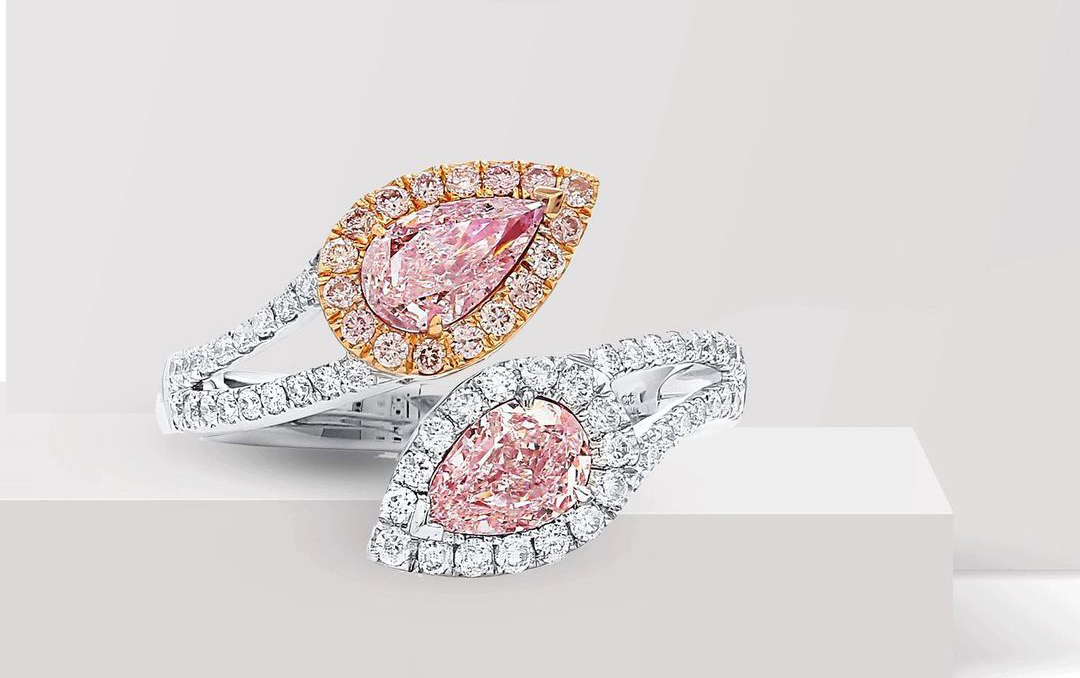The 4Cs:
The value of a gemstone is determined by several characteristics. This is called the value factors. As with other gemstones, diamonds of exceptional quality are rarer and more valuable than diamonds of lesser quality. There is no other way to compare diamonds except through a systematic evaluation and examination based on the value factors.
Diamond experts classify diamonds based on four specific factors: Clarity, Color, Cut, and Carat Weight, which are known as the 4Cs. With this evaluation, the quality of a polished diamond can be described, which is directly related to the diamond’s value.
Clarity:
There is almost nothing perfect in nature; this is true for diamonds as well as other materials. Diamonds have internal features called inclusions and surface flaws called blemishes. These are collectively called clarity features. Clarity refers to the relative absence of inclusions and blemishes.
Clarity Scale (Figure 1) :
• Inclusions refer to the impurities that diamond incorporates during growth.
• Blemishes refer to growth lines and scratches on the diamond’s surface.
The 5 Factors in Clarity Grading:
The five factors that determine a diamond’s clarity grade is related to how easily the grader can see the features. The five factors are as follows: the size, number, position, color or relief, and nature of a diamond’s characteristics.
Size:
Usually, large inclusions have more impact on the clarity than small ones; the larger an inclusion, the lower the clarity grade will be.
Number:
The number of inclusions is important; however, the type of inclusion and how easy it is to see makes a big difference. Some stones with a high level of micro inclusion can be highly evaluated on a clarity scale. The grade is usually determined by one or two of the largest inclusions.
Position:
The position of inclusions also affects the appearance. Gem cutters call the area just below the table, the heart (Figure 2). Inclusions in this position are more clearly visible than those near the bezel facets or girdle (Figure 2).
Color or Relief:
Relief refers to the contrast between inclusions and diamonds. Inclusions that are in different colors from a diamond, such as very light, dark, or colored, are easily visible; therefore, affect the clarity grade more than those with transparent inclusions.
Nature:
Nature refers to the types of inclusions and their effect on diamonds. For example, optical defects in a crystal formation have far less effect on a diamond’s clarity grade than physical cracks. Very deep feathers extending from the crown to the pavilion (Figure 2) can create durability concerns and lower the clarity grade.
Names of each surface and each part of the round brilliant cut are shown in Figure 2 above.
• A gem cutter is a craftsman who cuts diamonds by splitting or sawing.
• Defects in a crystal formation causes inclusions, usually appearing as ripples or thin lines.
• A feather is a crack inside a diamond that looks like a bird’s feather.
Below is the GIA Clarity Scale:
• Flawless (FL)
Flawless diamonds are ones that show no blemishes or inclusions when examined under 10x magnification. They are extremely rare and are rarely seen in jewelry stores. A diamond is considered flawless even if it has the following characteristics:
Extra facets that are not visible when viewed face up.
Naturals that are within the girdle that do not thicken the girdle or distort its contours.
Internal graining that is not reflective, white, or colored, and does not affect the transparency of the diamond.
Engraving that does not penetrate the interior when viewed under 10x magnification.
• Internally Flawless (IF)
Internally Flawless diamonds refer to ones that do not show any inclusions when examined under 10x magnification. However, minor blemishes such as surface graining, naturals, and extra facets can be seen. Blemishes other than surface graining can be removed by repolishing the diamond, which can upgrade the clarity grades of Internally Flawless diamonds to Flawless diamonds, but this is rarely done.
• Very Very Slightly Included (VVS1・VVS2)
VVS diamonds contain minute inclusions that are extremely difficult (VVS1) or very difficult (VVS2) to see under 10x magnification. Typical inclusions that determine a clarity grade include internal graining, pinpoints, needles, minute feathers, and chips.
• Very Slightly Included (VS1・VS2)
VS diamonds contain minor inclusions that are difficult (VS1) or somewhat easy (VS2) to see under 10x magnification. Typical inclusions include small crystals, distinct clouds, and small feathers, but it could be other kinds of inclusions as well.
• Slightly Included (SI1 and SI2)
SI diamonds contain well-defined inclusions that are either easy to see (SI1) or very easy to see (SI2) under 10x magnification. Typical inclusions are crystals, feathers, clouds, and twinning wisps, but it could also be other kinds of inclusions.
• Included (I1, I2, I3)
I1, I2, and I3 diamonds contain significant inclusions when seen under 10x magnification. There are large feathers and crystals, and these inclusions can affect the transparency and brilliance of a diamond.
There is definitely demand for I1 and I2 diamonds, which are sold in many retail stores. It is especially attractive to customers who want the largest possible diamond and are willing to compromise on the clarity. The I3 diamonds are less popular. This grade often lacks transparency and durability.
Terms:
• The table refers to the flat facet of a diamond, which can be seen when the stone is viewed face up.
• Extra facets are additional facets on top of the usual number needed for the diamond to be characterized as a specified cut, such as round, cushion, princess, etc. They are not included in the overall faceted pattern or symmetry of the diamond, and they are usually near the girdle.
• Surface graining on a diamond appears as lines due to defects in its crystal formation. They are usually seen on the surface of a diamond.
• Natural is a part of the rough diamond’s surface left on the diamond after polishing. It is usually found at or near the girdle.
• Pinpoints are microscopic crystals that look like tiny dots under 10x magnification.
• Needles are long, thin crystals that look like needles at 10x magnification.
• Internal graining is white, colored, or reflective straight, curved, or angular lines that affect transparency of a diamond when observed under 10x magnification due to irregular crystal growth in its structure.
• A chip is a rounded, shallow hole on the surface of a diamond, usually near the girdle, culet, or facet junctions.
• A crystal inclusion is referred to a mineral crystal contained within a diamond.
• A cloud inclusion is a large number of very small pinpoints gathered together to form a cloudy appearance.
• Twinning wisps are a series of pinpoints, clouds, or crystals that form during the growth of a diamond. They occur as a result of crystal distortion or twinning.
Color:
Diamond Color Scale:
Colors of diamonds are graded on a scale of D (colorless) through Z (light color), but it does not indicate actual colors or hues. Each letter represents a range of colors based on a combination of light (darkness or lightness) and saturation (intensity). This combination is called color density and is the measurement, by which the color is judged. Diamonds with slightly different color densities may fall into the same color grade. Colors are more easily observed in larger diamonds than in smaller diamonds. Only skilled graders can distinguish the D – F range for diamonds weighing less than 0.25 carat, and only if the diamonds are not set or mounted.
Cut:
In a well-cut diamond, light works in breathtaking ways, beautifully demonstrating the diamond’s three elements of brilliance: brightness, fire, and scintillation.
From top to bottom, the crown, girdle, and pavilion are the auspicious parts of polished diamonds. The crown and pavilion, and sometimes the girdle, have flat polished surfaces called facets. Some polished diamonds have a flat faceted surface called a culet at the bottom of the pavilion.
Terms:
• Brightness is a term describing all white effects reflected in the internal and external facets of a diamond.
• Fire describes the colored, or rainbow, sparkle that you can see when the stone is exposed to light.
• Scintillation refers to the sparkle of a diamond when it is viewed in motion.
Below is the basic diamond proportions:
• Girdle Outline
The girdle outline is the shape of a diamond when observed face up.
• Table Size
Table size is important because it affects the amount of light entering and exiting the diamond.
• Crown Angle
• Girdle Thickness
• Depth Percentage of the Pavilion
• Culet Size
• Length to Width Ratio (for Fancy Shapes)
GIA Cut Scale:
Knowing the GIA Diamond Cut Grading System makes it easy to evaluate the characteristics of a diamond’s appearance. Based on this scale, the cut quality of a round brilliant diamond can be evaluated, which is the most important yet standard cut of all. Any clarity in the range of colors from D to Z is accepted. There are five cut grades: Excellent, Very Good, Good, Fair, and Poor.
Carat Weight:
This is one of the evaluation criteria for diamonds, which represents the weight. The unit is ct.; 1 ct. means 0.2 grams. Diamonds in particular, the weight is measured and displayed to three decimal places. The heavier the stone, the more valuable it is, if all the other characteristics of the 4Cs are graded similarly. The following table is a rough estimate of the size of a typical round cut diamond (round brilliant cut). 。
The carat weight and dimensions of a diamond affect its value.











